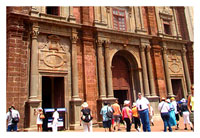 You will need your imagination to envision the tangle of twisting streets, plazas and ochre villas of the old city, but what remains is a wealth of exceptionally impressive churches and convents, all UNESCO world heritage sites. You will need your imagination to envision the tangle of twisting streets, plazas and ochre villas of the old city, but what remains is a wealth of exceptionally impressive churches and convents, all UNESCO world heritage sites.
Your first stop is the Basilica of Bom Jesus, a fine example of Jesuit architecture, and perhaps the richest of the churches, with its heavily decorated yet admirably proportioned interior. Here worshipers, or the simply curious, may view the body of Saint Francis Xavier (d.1562), which lies partially exposed in a dazzling silver casket. Its surrounding chapel, constructed of marble and jasper, was a gift of one of the last Medicis.
The Se, or St. Catherine’s Cathedral, was commissioned to be a grandiose church worthy of the wealth, power and fame of the Portuguese who dominated the seas from the Atlantic to the Pacific. It is still larger than any church in Portugal.
It is not far to the Church of St. Cajetan, modelled on St. Peter’s in Rome. Its neo classical facade, with twin towers flanking the great dome, disguises an interior that is pure, unrestrained baroque. Hidden beneath the church is a crypt where the embalmed bodies of Portuguese governors were kept in lead coffins before they were shipped back to Lisbon.
In the village of Merces is the ancestral home of the Oliviera de Fernandes family. The Fernandes family have been living here since the house was built 250 years ago, acting as village heads until Goa officially joined the Indian Republic. Your hosts today are the 6th generation of occupants.
Experience true Goan hospitality as the family welcome you. A local band will strike up a serenade as a late morning tea of tasty Goan snacks is laid out for your enjoyment. Feel free to browse among the antiques in the living room. The furniture is 300 years old and solid wood.
On your way back to the ship you drive through the Panjim city area, Goa’s bustling capital.
 |